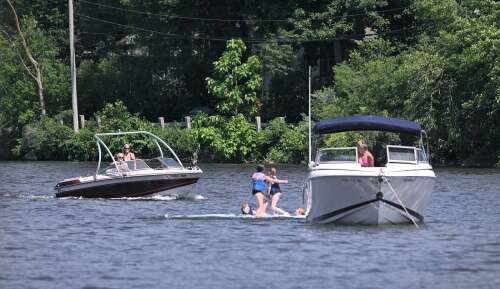Water safety experts say staying safe on Illinois waterways requires recognizing one’s abilities and understanding how to self-rescue using the flip-float-and-follow strategy.
John Starks/jstarks@dailyherald.
When it comes to water safety, Sgt. Ari Briskman, commander of the Lake County Sheriff’s Department marine unit, urges enthusiasts to stay sober and recognize their abilities — or lack thereof — when swimming or operating a water vessel.
Consuming alcohol or drugs and making poor choices contribute to most major water incidents, he said.
“At the start of the season, we see an uptick in crashes and serious incidents,” Briskman said.
On Wednesday, his unit helped rescue two teens stranded on paddleboards. The unit also responded to a fatal crash Tuesday involving a boat and a personal watercraft. While alcohol did not factor into either incident, inexperience may have played a part, Briskman said.
Briskman’s unit mostly responds to people in the water and minor crashes between boats or personal watercraft. Incidents number 25 to 35 annually and typically involve one or more impaired individuals, he said.
Boaters should know their limitations and operate within them, he says. It’s also imperative that everyone on board wear a life vest, including pets.
“A life jacket doesn’t do you any good if it’s not on you,” he said.
Additionally, a vessel should have a flotation device, like a ring buoy, to throw to someone overboard.
If you find yourself overboard, “the first thing to do is not panic,” said Briskman.
That is easier said than done, said Dave Benjamin, co-founder and executive director of the Great Lakes Surf Rescue Project, a not-for-profit that offers water safety training.
Panic is the first stage of drowning, he said, and it is “excruciatingly difficult in water over your head to alleviate a panic attack.”
He recommends the flip-float-and-follow strategy. First, flip over onto your back. Floating helps conserve energy and inflate your lungs, making you more buoyant. It also provides oxygen to the brain, allowing you to think clearly, he said. At that point, you can follow a path to safety.
“If you’re in a current, you want to float to see if you can ascertain which way the current is flowing, which way it is pulling you,” Benjamin said. “You don’t want to swim against the current.”
A Great Lakes surfer, his nonfatal drowning in 2010 inspired the Homewood resident to cofound the GLSRP in 2011 with retired Michigan fire marshal and firefighter/paramedic Bob Pratt.
“People believe if they and their kids know how to swim, they don’t have to worry about drowning. That’s a huge misnomer,” said Benjamin.
He recommends classroom water safety lessons as well as swim lessons for children and adults. The GLSRP offers safety classes at glsrp.org/classes.
“I don’t want to take anything away from swim lessons,” he said, but “we need to be equally aggressive with water safety education in a classroom setting.”
Benjamin also suggests being aware of wind conditions and the water current and swimming near lifeguards.
Both Benjamin and Briskman caution swimmers against overestimating their abilities.
According to the American Red Cross, 80% of Americans say they swim, but only 46% can perform basic skills that could save their lives. To that end, swimmers should be able to jump in water over their head, return to the surface and tread water or float for one minute. Then, they should be able to turn full circle, find an exit and swim 25 yards without stopping. Finally, they need to be able to exit the water without a ladder.
Last year, Benjamin and members of his immediate family assisted 15 people who got into trouble in the water. Most of those assists involved people on inflatable rafts or inner tubes.
Benjamin encourages water enthusiasts to recognize signs of a swimmer in distress. Drowning looks nothing like Hollywood portrays it, he said. A drowning person is exhausted and cannot wave or yell for help. The person is vertical, mouth at water level and head tilted back, Benjamin said. Lastly, the person appears to be climbing a ladder, with hands barely breaking the surface.
If rescuers extricate someone in under two minutes and administer rescue breaths and CPR properly, the swimmer likely will make a full recovery, Benjamin said. At three minutes, the heart stops. At four minutes, irreversible brain damage sets in, he said.
After 10 minutes, a would-be rescue becomes a body recovery.
A young child, unable to swim, will go under instantaneously, he said. Weak swimmers may sink after 20 to 30 seconds. Even strong swimmers can submerge in less than a minute, he said.
Would-be rescuers should not jump in to assist a drowning person unless they are trained lifeguards with flotation devices, Benjamin said. Instead, they should throw the individual a flotation device, alert a lifeguard and call 911.
“Thankfully, crashes involving serious injuries and fatalities are fairly uncommon on Lake County waterways,” said Sgt. Ari Briskman, commander of the Lake County Sheriff’s Department marine unit.
John Starks/jstarks@dailyherald.com
